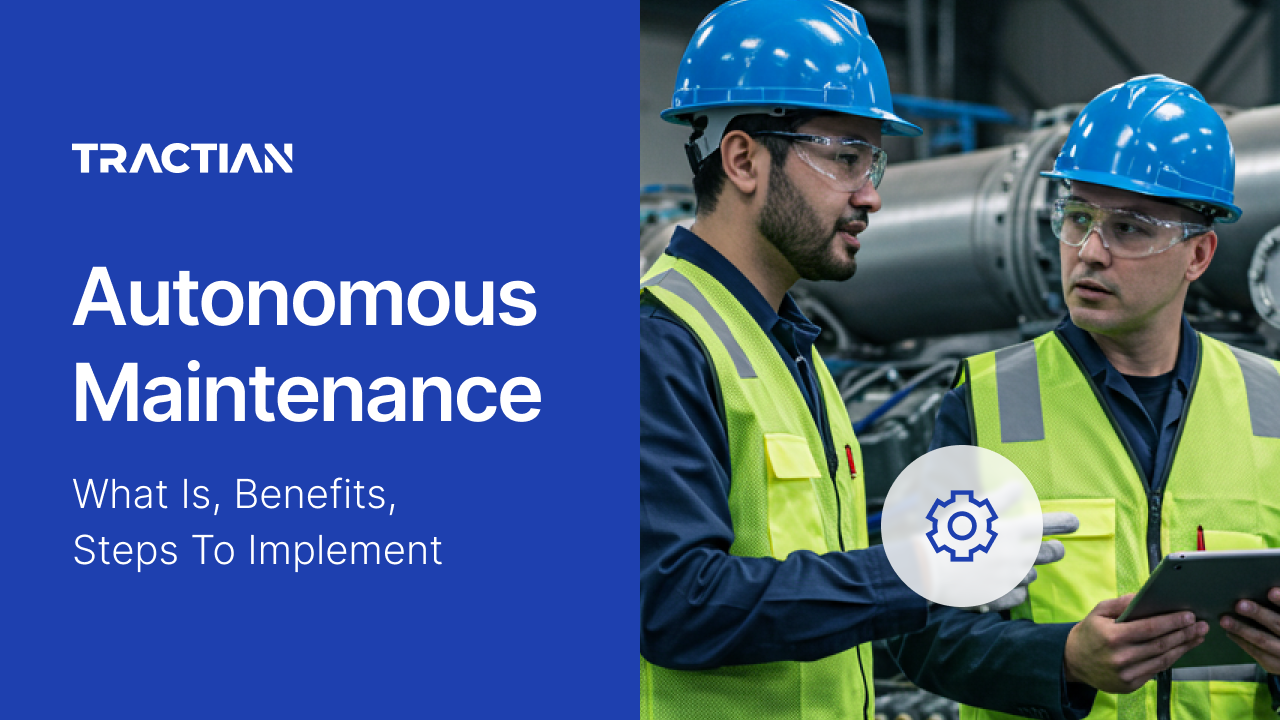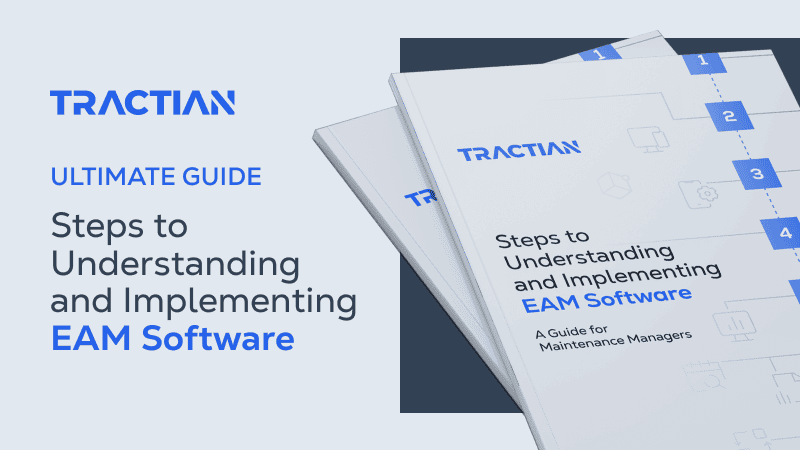The same pattern shows up in nearly every plant: Small issues build up, and maintenance teams get pulled in again and again to fix things that should’ve never made it this far.
It's not because technicians aren't doing their job, far from it. This happens because they’re doing everyone else’s jobs. That’s the breaking point where autonomous maintenance becomes non-negotiable.
Instead of running every minor task through the maintenance backlog, autonomous maintenance shifts basic responsibilities like cleaning and inspecting to the operators who work with the machines every day.
It creates a line of defense where problems start (and where they’re easiest to prevent).
This helps machines stay healthier, reduces downtime, and gives technicians time back to actually work on high-value tasks.
In this article, we’ll break down what autonomous maintenance really is, how it fits into modern maintenance strategies, and what it takes to build a program that sticks.
What Is Autonomous Maintenance?
Autonomous maintenance is a structured approach that shifts the responsibility of routine equipment upkeep to its operators. We're not talking about full-scale overhauls, just cleaning, basic inspections, and early detection.
Basically, the kind of tasks that don’t need a technician, but often end up consuming their time anyway.
No one knows how a machine behaves day-to-day better than the person running it. That kind of proximity creates an opportunity, not just for faster response, but for prevention.
When operators are trained to spot wear, noise, vibration, leaks, or misalignments early, issues get flagged before they escalate.
And even more importantly, autonomous maintenance builds a culture of ownership. It connects production and maintenance, closing the communication gap so equipment stays in good condition without waiting for someone else to notice a problem.
It’s also one of the foundational pillars of Total Productive Maintenance (TPM): the framework that redefined how world-class operations think about asset reliability.
Principles of Autonomous Maintenance
At its core, autonomous maintenance is driven by shared responsibility. It’s not a tool, it’s a cultural shift. And like any shift, it stands on a few non-negotiable principles that bring structure and keep the process working in the long term.
1. Ownership at the Source
Operators don’t just run machines,they maintain the frontline conditions that keep them reliable. When the person closest to the asset is also responsible for keeping it clean, lubricated, and visually checked, issues stop slipping through the cracks.
2. Standardization of Tasks
There’s no room for guesswork on the plant floor. Equipment care should be standardized, both visually and procedurally. Think color-coded tags, visual checklists, and clear routes for escalation when potential issues are found.
The goal is to make basic care part of the daily rhythm, not an extra step.
3. Continuous Skill Development
Autonomous maintenance only works if operators know what to look for. Ongoing training makes it possible for operators to learn each machine’s specific behaviors and red flags.
The more operators understand their machines, the faster and more confident they become in solving minor issues.
4. Collaboration With Maintenance Teams
When operators take care of the basics, technicians are freed up to focus on diagnostics, system-level improvements, and solving complex failures.
This division of responsibility boosts productivity on both sides and minimizes bottlenecks.
5. A Culture of Continuous Improvement
Autonomous maintenance isn’t static. Teams that succeed revisit procedures and gradually increase operators’ autonomy as their confidence and competence grow. It’s a gradual climb that’s always moving forward.
Autonomous Maintenance vs. Preventive Maintenance
It’s easy to confuse autonomous maintenance with preventive maintenance. After all, both aim to reduce downtime.
The difference lies in who’s responsible, what tasks are involved, and how each approach fits into your day-to-day operations.
Who Does What
Autonomous maintenance starts with the operator. It places day-to-day care into the hands of the person who knows the equipment best.
These aren’t optional tasks; they’re standardized and scheduled so machines can continue to perform over time.
Preventive maintenance is executed by trained technicians. It’s more structured and often more invasive.
Preventive maintenance tasks require technical knowledge, specific tools, and, in some cases, equipment downtime.
How They're Scheduled
Autonomous maintenance is embedded into operators’ daily routines. Tasks happen frequently, sometimes multiple times per shift, with the ultimate goal of keeping equipment functioning consistently.
Preventive maintenance, on the other hand, doesn’t happen every day. Instead, it’s strategically planned around specific intervals..
It relies heavily on data to hit the right service window without over-maintaining or wasting resources.
Depth of Intervention
Autonomous maintenance is surface-level by design. Its strength lies in how often it's performed and how it builds operator awareness.
When done right, it prevents small issues like contamination or loose components from growing into full-blown breakdowns.
Preventive maintenance goes deeper. It proactively addresses internal degradation by focusing on areas operators aren’t trained to handle.
Benefits of Autonomous Maintenance
Autonomous maintenance isn’t just about delegating tasks. It’s also about transforming the way teams interact with equipment.
When implemented properly, it’s a high-leverage strategy that drives culture change from the ground up.
Here’s what that looks like in practice:
Prevents Equipment Deterioration
Most equipment doesn’t fail overnight. Dirt, misalignment, loosened fasteners, etc, are often the root causes behind more serious breakdowns.
These small issues are exactly what autonomous maintenance is designed to catch.
Operators perform regular inspections so wear and abnormalities are. That means you’re no longer waiting for vibration data to spike or for a part to fail before acting.
Instead, you’re dealing with issues at the surface.
Over time, this habit of early intervention stabilizes asset conditions, so reactive maintenance can take a backseat.
Instills a Sense of Ownership and Responsibility
When operators are trained to take care of their own machines, something changes.
Instead of seeing maintenance as someone else's job, operators start identifying with the health of their equipment. They understand failure points and can recognize when something’s off.
That shift creates accountability where it matters most-on the shop floor, where problems begin.
And this isn’t just theory. Teams with strong autonomous maintenance programs report fewer blame cycles, faster issue resolution, and tighter alignment between production and maintenance.
Promotes a Culture of Quality and Safety
There’s a direct link between machine condition and plant safety. Things like leaks or loose components-these aren’t just precursors to failure, they’re also serious safety risks.
Autonomous maintenance raises the visibility of these risks. When inspection and cleaning become part of the daily routine, hazards get flagged sooner.
7 Steps to Implement Autonomous Maintenance
Most maintenance programs fail because the rollout misses the floor. Tasks don’t stick because operators aren’t sure what’s theirs and what’s not.
Autonomous maintenance changes that by building one habit at a time. Each step adds another level of ownership until frontline care becomes just part of how things run. Here’s how teams make it work, from day one to full maturity:

1. Improve Operator Knowledge
Everything begins with training operators on the basics of how each machine works.
This isn’t about turning them into maintenance experts, but giving them enough knowledge to recognize issues early and act with confidence. When operators know what to expect from the equipment, they’re better prepared to protect it.
2. Set Baseline Standards
You can’t maintain what you haven’t defined. Establish what “good condition” looks like for each machine. For example, visual standards for cleanliness or acceptable noise levels.
This baseline becomes the reference point for inspections and care.
3. Deal With Root Causes of Contamination
Before routines begin, fix leaks, seal enclosures, and tighten mounts.
Cleaning for the sake of cleaning doesn’t cut it, you need to eliminate what’s causing dirt, dust, and debris in the first place. This step sets the foundation for real change.
4. Develop Lubrication and Inspection Standards
Operators need clear guidelines on how to lubricate and inspect each machine. These guidelines should explain why each action matters. This way, it becomes second nature over time.
5. Consistently Inspect and Monitor Assets
Inspections need to be part of the daily routine, not an afterthought. Simple, structured checklists help teams spot problems before they get bigger.
6. Standardize Visual Maintenance
Clarity drives autonomy. Visual cues like labels and diagrams help operators know what to do and when to escalate. Organize tools and inspection routes in a way that minimizes confusion and maximizes flow.
When the process is clear, routine tasks get done right.
7. Ensure Continuous Improvement
The last step is never really the last. Autonomous maintenance should evolve with your operation. A great way to do this is by creating a feedback loop of reviewing and adjusting responsibilities as operators’ skills grow.
What starts with cleaning and inspecting can eventually scale to minor repairs and real-time reporting, making your frontline stronger every month.
Three Activities Integral to Autonomous Maintenance
You can have the right steps and the right mindset, but if you don’t lock in the routines that support autonomous maintenance, it falls apart fast.
These three activities keep the system alive:
5S Audit
5S is the operational backbone of autonomous maintenance. Without a clean, organized environment, it’s impossible to notice when something’s off. But it’s not just about cleanliness, it’s about control.
Does every tool have a place? Is every surface clear?
When 5S is done right, operators can instantly spot issues. And when audits happen regularly, it sends a clear message: daily discipline matters.
Our environment reflects our mindset, and 5S ensures both stay sharp.
Abnormality Management
Autonomous maintenance only works if operators know how to react when something isn’t right. Abnormality management gives them a clear process to recognize, tag, and track every anomaly.
It’s not “just something odd”-it’s a signal.
Color-coded tags and standard escalation flows make sure these findings don’t disappear into the void. And over time, this system builds pattern recognition.
CILs and Centerlines
Cleaning, Inspection, and Lubrication (CIL) routines aren’t optional, they’re the heartbeat of autonomous maintenance. These tasks keep machines running within defined parameters, day in and day out.
Centerlines take that a step further. They define the optimal settings that machines should always return to after adjustments. Operators use them as a reference point, keeping performance tight and drift under control.
Together, CILs and centerlines reduce variability and give operators a clear target for daily machine health.
Tips for Sustaining Autonomous Maintenance as You Scale
Getting autonomous maintenance off the ground is one thing. Keeping it alive as your operation expands is another.
The shift from pilot to plant-wide is where your team’s discipline really gets tested. But with the right habits, scaling autonomous maintenance becomes much easier.
Here’s how to make that happen:
Start with a Strong Foundation-Then Replicate It
Before thinking about site-wide rollout, make sure your first implementation is airtight. Operators know their tasks. Standards are documented and visual. Audits are routine.
Once that first line is running smoothly, use it as your blueprint to replicate the processes and culture supporting it.
Invest in Visual Management
Scaling requires clarity. You shouldn’t have to explain the standard twice, it should be visible on the floor, embedded into the equipment, and instantly understandable across shifts and roles.
Document and Standardize
What works in one area won’t work everywhere unless it’s clearly documented and easy to transfer. Create detailed AM guides for each asset that include photos, timelines inspection points, and other important information.
Create Feedback Loops From the Floor Up
The best programs aren’t top-down; they evolve based on what frontline teams are seeing. .
If something isn’t being done, it’s usually not because people don’t care, it’s because the process didn’t fit.
Track What Matters and Share the Wins
You don’t need a hundred KPIs. Start with the basics: how many abnormalities are caught by operators? How many tickets are resolved before reaching failure?
Track it, share it, and don’t forget to celebrate wins. Results drive buy-in more than any memo ever could.
Don’t Let Growth Dilute the Discipline
It’s easy to relax standards once things feel stable, but that’s when things start slipping. Stay consistent with audits, and hold teams accountable not just for doing tasks, but for improving them.
How Does a CMMS Help With Autonomous Maintenance?
Autonomous maintenance thrives on structure. Tasks need to be clear, repeatable, and traceable. Operators need visibility. Technicians need alignment. And leadership needs proof that the system is working.
Tractian’s CMMS is built to support exactly that.
Our solution centralizes every step of the autonomous maintenance process, so operators know exactly what to do without stepping outside their workflow.
Abnormalities are flagged instantly, complete with the full context, so maintenance teams get the real-time visibility they need.
Tractian's CMMS is easy to implement and grow with your operation. You can replicate successful autonomous maintenance routines across multiple lines or plants, while still tailoring them by asset or site.
Everything’s tracked, everything’s visible, and every action feeds back into your reliability strategy.
Start building a more autonomous operation today. See how Tractian’s CMMS adapts to your team’s reality.



